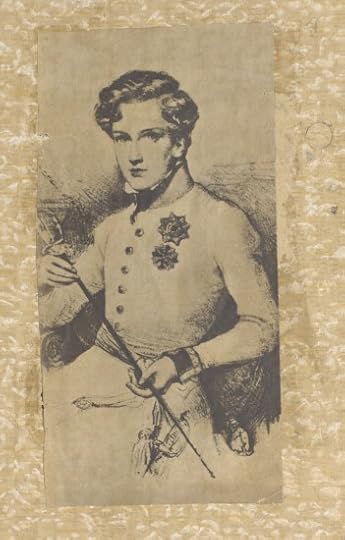Moniek Bloks's Blog, page 9
July 17, 2025
Queen Alexandrine’s Fringe Tiara
Queen Alexandrine’s Fringe Tiara was a gift to Grand Duchess Anastasia Mikhailovna of Russia upon her marriage to the future Friedrich Franz III, Grand Duke of Mecklenburg-Schwerin, in 1879 from her uncle, Tsar Alexander II of Russia.
Following Anastasia’s death in 1922, the tiara was inherited by her eldest daughter, Alexandrine, who was the Queen of Denmark. It quickly became Alexandrine’s favourite tiara, and she wore it on many occasions.
Embed from Getty ImagesWhen Queen Alexandrine died in 1952, she bequeathed the tiara to the wife of her younger son, Princess Caroline-Mathilde of Denmark, Hereditary Princess of Denmark. Had the law not changed to allow Princess Margrethe to become Queen, Caroline-Mathilde would have eventually become Denmark’s Queen consort. She, too, wore the piece often.
After the death of Princess Caroline-Mathilde in 1995, her eldest son, Count Ingolf of Rosenborg, inherited the piece. His wife passed in 1996, so there was no one to wear it. He did loan it out briefly to his sister, Princess Elisabeth. He remarried in 1998, and the tiara is now worn by his wife, Sussie.1
The post Queen Alexandrine’s Fringe Tiara appeared first on History of Royal Women.
July 16, 2025
New photo of Queen Camilla for 78th birthday
Buckingham Palace has released a new photo of Queen Camilla for her 78th birthday today.
The photo was taken this month in the garden at Raymill, which is Queen Camilla’s private home in Wiltshire. The photo was taken by Chris Jackson.
 Chris Jackson/Getty Images for Buckingham Palace
Chris Jackson/Getty Images for Buckingham PalaceQueen Camilla was born Camilla Rosemary Shand on 17 July 1947 as the daughter of Major Bruce Shand and his wife, The Honourable Rosalind Cubitt, at King’s College Hospital in London. Her mother was the daughter of Roland Cubitt, 3rd Baron Ashcombe and Sonia Rosemary Keppel. Her first marriage to Andrew Parker Bowles was on 4 July 1973. They had two children, a son named Tom (born 1974) and a daughter named Laura (born 1978). They were divorced in 1995.
On 9 April 2005, she married the then-Prince of Wales. As a result, Camilla became known as The Duchess of Cornwall. She was officially The Princess of Wales but chose not to use the title as it remains strongly associated with Diana, Charles’s first wife. On 8 September 2022, upon the death of her mother-in-law, Queen Elizabeth II, Camilla became the new Queen (consort). As such, she is addressed as Her Majesty The Queen.
The post New photo of Queen Camilla for 78th birthday appeared first on History of Royal Women.
July 15, 2025
Princess Jinling – The banished Princess
Princess Jinling was the daughter of Emperor Xiaowen of the Eastern Jin Dynasty. She was also the sister of Emperor An and Emperor Gong of the Eastern Jin Dynasty. However, her life was often fraught with tragedy.[1] During Duke Liu Yu’s regency, Princess Jinling’s husband, Duke Xie Hun of Chen, was executed.[2] Therefore, Princess Jinling was a very unhappy princess.[3]
The birthdate of Princess Jinling is unknown.[4] Her personal name is unknown. She was given the title of Princess of Jinling.[5] She was the daughter of Emperor Xiaowen of the Eastern Jin Dynasty. Her mother was one of Emperor Xiaowen’s imperial concubines whose name is not recorded.[6] Princess Jinling had two brothers named Sima Dezong (who would later become Emperor An) and Sima Dewen (who would later become Emperor Gong). She also had a sister who would become known in history as Princess Poyang.[7]
It is unknown when Princess Jinling married Duke Xie Hun of Chen.[8] Duke Xie Hun was the grandson of Xie An and the son of Xie Yan.[9] It is unknown if she had any children.[10] On 6 November 396 C.E., Emperor Xiaowu was murdered by his favourite imperial concubine, Imperial Consort Zhang.[11] Emperor Xiaowu was succeeded by Emperor An. Emperor An was mentally disabled and could not speak.[12] Therefore, he needed a regent.[13] In 405 C.E., the regent of the Eastern Jin Dynasty was Liu Yu (the Duke of Song).[14]
In 412 C.E., Princess Jinling’s husband, Duke Xie Hun of Chen, offended Duke Liu Yu.[15] Duke Liu Yu executed Duke Xie Hun of Chen.[16] Her husband’s execution forced Princess Jinling to leave the Xie family.[17] On 28 January 419 C.E., Duke Liu Yu installed Emperor Gong on the throne.[18] On 7 July 420 C.E., Emperor Gong abdicated.[19] This marked the end of the Jin Dynasty.[20] Liu Yu ascended the throne as Emperor Wu and founded the new Liu-Song Dynasty.[21]
Shortly after the founding of the Liu-Song Dynasty, Princess Jinling was demoted to Princess of Dongxiang.[22] However, she was allowed to return to the Xie family because of her “good morals.”[23] After she returned to the Xie family, the rest of Princess Jinling’s life is unknown.[24] She died in 432 C.E..
There is very little information known about Princess Jinling.[25] However, it is clear that she faced many hardships.[26] Her husband was executed, and she was cast out by her husband’s family.[27] Princess Jinling was even demoted to Princess of Dongxiang.[28] Because of her virtues, she was finally able to return to the Xie family.[29] Princess Jinling also witnessed the fall of the Jin Dynasty and the beginning of the founding of the Liu-Song Dynasty.
Sources:
iNews. (n.d.). “The Tragic Life of Sima Dewen, Emperor Gong of Jin”. Retrieved on 30 November 2024 from https://inf.news/en/history/6fcd788fe....
McMahon, K. (2013). Women Shall Not Rule: Imperial Wives and Concubines in China from Han to Liao. NY: Rowman and Littlefield.
Theobald, U. (16 June2018). “Jin Andi 晉安帝 Sima Dezong 司馬德宗”. Chinaknowledge.de- An Encyclopedia on Chinese History, Literature, and Art. Retrieved on 28 November 2024 from http://www.chinaknowledge.de/History/....
[1] iNews, n.d., “The Tragic Life of Sima Dewen, Emperor Gong of Jin”
[2] iNews, n.d., “The Tragic Life of Sima Dewen, Emperor Gong of Jin”
[3] iNews, n.d., “The Tragic Life of Sima Dewen, Emperor Gong of Jin”
[4] iNews, n.d., “The Tragic Life of Sima Dewen, Emperor Gong of Jin”
[5] iNews, n.d., “The Tragic Life of Sima Dewen, Emperor Gong of Jin”
[6] iNews, n.d., “The Tragic Life of Sima Dewen, Emperor Gong of Jin”
[7] iNews, n.d., “The Tragic Life of Sima Dewen, Emperor Gong of Jin”
[8] iNews, n.d., “The Tragic Life of Sima Dewen, Emperor Gong of Jin”
[9] iNews, n.d., “The Tragic Life of Sima Dewen, Emperor Gong of Jin”
[10] iNews, n.d., “The Tragic Life of Sima Dewen, Emperor Gong of Jin”
[11] McMahon, 2013
[12] Theobald, June 16, 2018, “Jin Andi 晉安帝 Sima Dezong 司馬德宗”
[13] Theobald, June 16, 2018, “Jin Andi 晉安帝 Sima Dezong 司馬德宗”
[14] Theobald, June 16, 2018, “Jin Andi 晉安帝 Sima Dezong 司馬德宗”
[15] iNews, n.d., “The Tragic Life of Sima Dewen, Emperor Gong of Jin”
[16] iNews, n.d., “The Tragic Life of Sima Dewen, Emperor Gong of Jin”
[17] iNews, n.d., “The Tragic Life of Sima Dewen, Emperor Gong of Jin”
[18] McMahon, 2013
[19] McMahon, 2013
[20] McMahon, 2013
[21] McMahon, 2013
[22] iNews, n.d., “The Tragic Life of Sima Dewen, Emperor Gong of Jin”
[23] iNews, n.d., “The Tragic Life of Sima Dewen, Emperor Gong of Jin”, para. 33
[24] iNews, n.d., “The Tragic Life of Sima Dewen, Emperor Gong of Jin”
[25] iNews, n.d., “The Tragic Life of Sima Dewen, Emperor Gong of Jin”
[26] iNews, n.d., “The Tragic Life of Sima Dewen, Emperor Gong of Jin”
[27] iNews, n.d., “The Tragic Life of Sima Dewen, Emperor Gong of Jin”
[28] iNews, n.d., “The Tragic Life of Sima Dewen, Emperor Gong of Jin”
[29] iNews, n.d., “The Tragic Life of Sima Dewen, Emperor Gong of Jin”
The post Princess Jinling – The banished Princess appeared first on History of Royal Women.
July 13, 2025
Stateira I Shahbanu – The powerful Queen of the Achaemenid Empire who was murdered by her mother-in-law
Stateira I Shahbanu was queen consort to King Artaxerxes II of the Achaemenid Empire. She was also the mother of Artaxerxes III of the Achaemenid Empire. She was very popular and influential during King Artaxerxes II’s reign. Stateira I Shahbanu was locked in a bitter power struggle with her mother-in-law, Parysatis I Shahbanu. This conflict caused Parysatis I Shahbanu to murder Stateira I Shahbanu.
The birthdate of Stateira I Shahbanu is unknown.[1] She was the daughter of the Persian nobleman Hydarnes.[2] She had two brothers named Tissaphernes and Terituchmes.[3] She eventually married Prince Artaxerxes II. She bore a son named Prince Artaxerxes III.[4]
Terituchmes was plotting a rebellion and had divorced King Darius II’s daughter, Princess Amestris.[5] This made King Darius II to be so enraged that he wanted to kill all of Hydarnes’s children.[6] However, Prince Artaxerxes II begged his mother, Parysatis I Shahbanu, to save Princess Stateira I’s life.[7] Terituchmes was executed.[8] However, Princess Stateira I’s and Tissaphernes’s lives were spared through the interference of Parysatis I Shahbanu.[9]
In 404 B.C.E., King Darius II of the Achaemenid Empire died. King Artaxerxes II became the next king.[10] Stateira I became queen.[11] Stateira I Shahbanu received a maid from Egypt.[12] This was part of a diplomatic effort so that the Achaemenid Empire would not attack Egypt.[13] Stateira I Shahbanu was very influential during King Artaxerxes II’s reign.[14] King Artaxerxes II dearly loved his queen.[15] Stateira I Shahbanu was also very popular with the people.[16] She would ride in carriages with the curtains open so that the people could greet her as it passed.[17]
Prince Cyrus the Younger rebelled against his brother, King Artaxerxes II. The rebellion was also supported by his mother, Parysatis I Shahbanu. This created a power struggle between Parysatis I Shahbanu and Stateira I Shahbanu, and they became enemies.[18] Prince Cyrus the Younger was defeated by Tissaphernes at the Battle of Cunaxa.[19] The battle consolidated King Artaxerxes II’s reign.[20] Parysatis I Shahbanu tried to stop King Artaxerxes II from killing Prince Cyrus the Younger but failed.[21]
One of the conflicts between Parysatis I Shahbanu and Stateira I Shahbanu concerned the execution of the Greek commanders that had been captured, especially regarding their leader, Clearchus.[22] Parysatis I Shahbanu wanted to save their lives.[23] However, Stateira I Shahbanu wanted their executions.[24] This was because she believed they posed a threat to King Artaxerxes II’s reign.[25] King Artaxerxes II listened to Stateira I Shahbanu.[26] He executed all but one of the Greek commanders who had assisted Tissaphernes.[27]
In 400 B.C.E., Parysatis I Shahbanu decided it was time to eliminate Stateira I Shahbanu. Parysatis I Shahbanu poisoned Stateira I Shahbanu through a servant named Gigis.[28] When King Artaxerxes II learned of his wife’s death, he was enraged.[29] King Artaxerxes II killed Gigis. He also banished Parysatis I Shahbanu to Babylon.[30] Parysatis I Shahbanu’s exile did not last long.[31] Instead, King Artaxerxes II recalled his mother back to the palace.[32]
Stateira I Shahbanu was one of the most powerful queens of the Achaemenid Empire.[33] She exerted a strong influence over her husband, King Artaxerxes II.[34] She was very devoted to her husband.[35] She was also beloved by her people, and her subjects were allowed to greet her.[36] However, her power made her become an enemy of her mother-in-law, Parysatis I Shahbanu.[37] The rivalry did not end until she was murdered.[38] Thus, Stateira I Shahbanu is truly a tragic figure.
Sources:
Badian, E. (2015). “STATEIRA”. Encyclopædia Iranica. Retrieved on November 29 2024 from https://www.iranicaonline.org/article....
Jackson, G. M. (2009). Women Leaders of Africa, Asia, Middle East, and Pacific. United States: Xlibris.
Smith, W. (1873). “Parysatis or Parysatis Ochus”. A Dictionary of Greek and Roman Biography and Mythology. London: Spottiswoode and Co. Retrieved on November 26, 2024 from https://www.perseus.tufts.edu/hopper/....
Smith, W. (1873). “Stateira”. A Dictionary of Greek and Roman Biography and Mythology. London: Spottiswoode and Co. Retrieved on November 29, 2024 from https://www.perseus.tufts.edu/hopper/....
Ussher, J. (2003). The Annals of the World. Green Forest, AR: New Leaf Publishing Group, Incorporated.
[1] Badian, 2015, “STATEIRA”
[2] Badian, 2015, “STATEIRA”
[3] Badian, 2015, “STATEIRA”
[4] Jackson, 2009
[5] Badian, 2015, “STATEIRA”
[6] Badian, 2015, “STATEIRA”
[7] Badian, 2015, “STATEIRA”
[8] Badian, 2015, “STATEIRA”
[9] Badian, 2015, “STATEIRA”
[10] Jackson, 2009
[11] Badian, 2015, “STATEIRA”
[12] Badian, 2015, “STATEIRA”
[13] Badian, 2015, “STATEIRA”
[14] Badian, 2015, “STATEIRA”
[15] Smith, 1873, “Stateira”
[16] Badian, 2015, “STATEIRA”
[17] Badian, 2015, “STATEIRA”
[18] Badian, 2015, “STATEIRA”
[19] Jackson, 2009
[20] Jackson, 2009
[21] Smith, 1873, “Parysatis or Parysatis Ochus”
[22] Badian, 2015, “STATEIRA”
[23] Badian, 2015, “STATEIRA”
[24] Badian, 2015, “STATEIRA”
[25] Badian, 2015, “STATEIRA”
[26] Badian, 2015, “STATEIRA”
[27] Badian, 2015, “STATEIRA”
[28] Ussher, 2003
[29] Smith, 1873, “Parysatis or Parysatis Ochus”
[30] Smith, 1873, “Parysatis or Parysatis Ochus”
[31] Smith, 1873, “Parysatis or Parysatis Ochus”
[32] Smith, 1873, “Parysatis or Parysatis Ochus”
[33] Badian, 2015, “STATEIRA”
[34] Smith, 1873, “Stateira”
[35] Badian, 2015, “STATEIRA”
[36] Badian, 2015, “STATEIRA”
[37] Ussher, 2003
[38] Ussher, 2003
The post Stateira I Shahbanu – The powerful Queen of the Achaemenid Empire who was murdered by her mother-in-law appeared first on History of Royal Women.
July 12, 2025
Book News Week 29
Book News week 29 – 14 July – 20 July 2025

The Graces: The Extraordinary Untold Lives of Women at the Restoration Court
Hardcover – 17 July 2025 (UK & US)

The Last Tsar: The Abdication of Nicholas II and the Fall of the Romanovs
Paperback – 17 July 2025 (UK)

Sophie: Saving the Royal Family
Hardcover – 17 July 2025 (UK & US)

Bloody Mary: A Graphic Biography of Mary Tudor
Hardcover – 15 July 2025 (US)
The post Book News Week 29 appeared first on History of Royal Women.
July 11, 2025
Elizabeth of Slavonia – Hungary’s forgotten heiress
Throughout history, there have been many royal heiresses who were moved back in the line of succession, due to the birth of a son in their family. However, Elizabeth of Slavonia, heiress of Hungary, is a rare example of a royal heiress being displaced due to the birth of female relatives. Elizabeth’s younger cousins were ahead of her in the line of succession because they were the daughters of the king, while Elizabeth was the daughter of the king’s younger brother.
Early Life
Elizabeth of Slavonia was born in 1352 or 1353 as the first child of Stephen of Hungary, Duke of Slavonia, and his wife, Margaret of Bavaria. She was born into the Capetian House of Anjou, which ruled Hungary at the time. Another branch of the family ruled Naples. Elizabeth’s father was the youngest son of Charles I, King of Hungary, and Elizabeth of Poland. By the time she was born, their oldest son, Louis, was King of Hungary. Also, by the time of her birth, the second son, Andrew, had been killed in Naples, so Stephen was heir to the throne of Hungary, since Louis did not yet have children. In 1354, Elizabeth gained a younger brother, John. However, later that same year, Stephen died. Upon his death, Elizabeth’s brother, John, became the new Duke of Slavonia and heir to the Hungarian throne. Their mother, Margaret, ruled Slavonia as John’s regent until 1356.
In 1356, Margaret returned to her homeland of Bavaria and soon remarried to a German knight, Gerlach von Hohenlohe. She left Elizabeth and John in Hungary. The two children were to be brought up in the court of their uncle, King Louis of Hungary.
Since Louis had no children of his own yet, Elizabeth was seen as a valuable bride. In 1356, she was betrothed to Jobst, the oldest son of John Henry, Margrave of Moravia, who in turn was the younger brother of Charles IV, Holy Roman Emperor and King of Bohemia. Jobst belonged to the House of Luxembourg.
Elizabeth’s brother, John, died in 1360, aged around six. Louis still did not have any children, so Elizabeth became his heir.
Heiress Presumptive to Hungary
Elizabeth’s status increased after the death of her brother. She was now first in line to the Hungarian throne. Louis’ uncle, King Casimir of Poland, did not have any sons and considered Louis a possible successor. Therefore, Elizabeth was an heir to both the Hungarian and Polish thrones. In February 1361, Elizabeth’s uncle and grandmother, Elizabeth of Poland, renewed the agreement of her betrothal to Jobst of Moravia. However, this did not last long, and the engagement was soon broken off, possibly due to a conflict Louis and his mother were having with Jobst’s uncle, the Emperor.
Around this time, Louis and his mother joined an anti-Luxembourg alliance with the House of Habsburg. Possibly as a result of this alliance, Elizabeth was betrothed to Albert III, Duke of Austria, who was from the House of Habsburg. Elizabeth and Albert were second cousins once removed, so a papal dispensation was required for them to marry, but the Pope did not grant it. This betrothal was broken off by 1365.
In 1365, the competition for Elizabeth’s hand continued. The Pope described Elizabeth as close to marriageable age, so it’s possible that at this time, there was hope to get her married as soon as possible. The Pope was suggesting a French marriage for Elizabeth, particularly to Philip, the younger brother of King Charles V of France. However, Louis seems to have reconciled with Emperor Charles around this time. The Emperor wanted Elizabeth to marry his eldest son and heir, Wenceslaus. Louis agreed to this arrangement, and on 27 February 1366, Louis promised Elizabeth, about thirteen, to five-year-old Wenceslaus. Louis’ mother, however, was not in favour of this marriage.
By this time, Louis may have been considering another successor, Charles of Durazzo, who also belonged to the Capetian House of Anjou. Charles had arrived in Hungary in 1364 or 1365. It is also worth mentioning that at this time, Louis was still hoping to gain the throne of Poland from his uncle. Since Louis’s claim to Poland came from his mother, Charles would only be eligible to inherit Hungary. It could be possible that Louis considered Charles his successor in Hungary and Elizabeth his successor in Poland.
Elizabeth’s engagement to Wenceslaus did not last, and it was broken off in 1369, possibly with her grandmother’s encouragement. Soon afterwards, a change in fortunes happened to the childless Louis. His wife, Elizabeth of Bosnia, gave birth to a daughter named Catherine in 1370. She became pregnant again soon afterwards. Louis no longer needed Elizabeth or Charles as his heirs.
Marriage and Later Life
Although she was no longer heiress presumptive, Louis still seems to have wanted to marry Elizabeth off. In October 1370, she was married to Philip III, Prince of Taranto, another member of the Capetian House of Anjou. Louis accended the Polish throne a month later.
Elizabeth’s new husband, Philip, was from the Taranto branch of the Capetian House of Anjou. He was the youngest of three sons born to Philip II, Prince of Taranto, and his second wife, Catherine II, Titular Latin Empress of Constantinople in her own right. The Latin Empire of Constantinople had been reconquered by the Byzantines in 1261, but the descendants of the Latin Emperors continued to use that title. Philip’s oldest brother, Robert, was Titular Latin Emperor of Constantinople, but died childless in 1364. The second son, Louis, had been married to Queen Joanna I of Naples as her second husband, but he died with no surviving children in 1362. Therefore, Philip was the last male member of the Taranto branch.
Elizabeth was Philip’s second wife. He had previously been married to Queen Joanna’s sister, Maria, as her third husband. Philip and Maria’s five children all died in infancy. Since Philip was the last of his line, he was probably hoping for Elizabeth to give him children. At the time of their wedding, Elizabeth was about 17 or 18, while Philip was about forty-one. The new couple lived in the kingdom of Naples, in present-day Italy. As a dower, Elizabeth was granted the Greek island of Corfu as a personal fief.
Elizabeth and Philip had just one son, named Philip, in 1371, but he died in infancy. Elizabeth was widowed on 25 November 1373 or 1374. Louis of Hungary had three daughters by now, so the chance of Elizabeth inheriting the Hungarian or Polish thrones was not high. After her husband’s death, it is not known what exactly happened to Elizabeth. It is sometimes said that she returned to the Hungarian court in Buda. It is also possible that she remained in Naples. Elizabeth did not marry again, and there seems to have been no plans for her to be remarried. It is likely that her uncle may not have wanted her to remarry, because if she did, her new husband could lay claim to the inheritance of his daughters, who were still small children.
Elizabeth, who had once been heir to the Hungarian throne, disappears from record after her husband’s death. It is not even known when she died. Even if she had returned to Hungary, Elizabeth most likely returned to Italy at some point and died there, because she was buried in the Cathedral of Taranto. It is known that she died before 6 April 1380, because when her grandmother wrote her will on that day, she gave 2,000 gold forints for Elizabeth’s funeral costs, and asked for her body to be returned to Buda. However, there seem to be no records on whether or not Elizabeth’s body was ever returned. Elizabeth of Poland possibly wanted her granddaughter to be buried in the Monastery of Saint Clare in Buda. The elder Elizabeth was buried there, according to her wishes, when she died in December 1380.
Elizabeth of Slavonia was not just survived by her grandmother, but also by her uncle, whom she was once determined to succeed. She would have been no more than twenty-seven when she died. Nothing seems to be known about Elizabeth’s own actions. With the limited information available about her, she just appears to be a pawn in the royal succession plans and marriage market, and little more is said about her when she was no longer needed as her uncle’s heir. We will never know what type of queen she could have been if given the chance.
Sources
Halasz, Eva; “Prince Stephen of Anjou (1332-1354)” (In Hungarian)
“Elzbieta Lokietkowna” at zamki.name
The post Elizabeth of Slavonia – Hungary’s forgotten heiress appeared first on History of Royal Women.
July 10, 2025
Princess Noriko’s Wave Tiara
Princess Noriko’s Wave Tiara was given to Princess Noriko of Takamado when she celebrated her 20th birthday in 2008. This is the age of majority in Japan.
Princess Noriko is the second daughter of Norihito, Prince Takamado and Hisako, Princess Takamado. Her late father was a first cousin of Emperor Akihito.
The tiara has stylised waves of diamonds and pearls, and she also received a necklace and earrings to make a parure. It was made by the jeweller Mikimoto.
Princess Noriko married Kunimaro Senge in 2014, and as per the Imperial Household Law, she gave up her imperial titles. Her beautiful tiara was worn during her farewell ceremony before returning to the imperial vaults.
You can view the tiara here.
The post Princess Noriko’s Wave Tiara appeared first on History of Royal Women.
July 8, 2025
Anne Frank and the Dutch and British royal families
Most will know the tragic story of Anne Frank, but did you know that Anne wrote about royal families in her now-famous diary?
Anne was born in Frankfurt, Germany, on 12 June 1929 as the youngest daughter of Otto Frank and Edith Holländer. Her elder sister, Margot, was born three years before her. The family emigrated to Amsterdam in the Netherlands after Adolf Hitler was appointed as Chancellor. Anne’s father established a branch of his distribution company in that location.
Before the war, Anne had traded cards with the images of the Dutch and foreign royals with her friend, Hannah.
On 10 May 1940, the Netherlands was invaded by Germany, and the following year, the family was stripped of their German citizenship, making them stateless. Otto Frank had been preparing for the family to emigrate to the United States, but all the paperwork was lost when the consulate was destroyed during the bombing of Rotterdam on 14 May 1940.
After the summer holidays of 1941, Anne and her sister Margot were forced to move to a Jewish school, the Jewish Lyceum. On 12 June 1942, Anne’s 13th birthday, she received an autograph book bound in cloth, which she decided to use as a diary. Three weeks later, on 6 July 1942, the family went into hiding in a three-story space above Otto’s office on the Prinsengracht. They were going to be helped by some of Otto’s most trusted employees. This place became known as the Achterhuis or the Secret Annex.
The first mention of the Dutch royal family comes on 21 September 1942. Anne wrote that she sometimes listened to the Dutch broadcasts from London. She wrote, “Prince Bernhard recently announced that Princess Juliana is expecting a baby in January, which I think is wonderful. No one here understands why I take such an interest in the Royal Family.’1 That baby was Princess Margriet, who was born in Canada on 19 January 1943. Anne later mentioned reading a genealogical chart, “right up to little Margriet Franciska (born in 1943 in Ottawa).”2
 The photo of the Dutch royal family which Anne received – Collection Anne Frank Stichting / [Trouw, 1943], A_Achterhuis_II_046.A08].On 30 December 1943, Anne received some small royal memorabilia from Bep, one of the women helping to conceal them. She wrote, “P.S. Bep had a picture postcard of the entire Royal Family copied for me. Juliana looks very young, and so does the Queen. The three little girls are adorable. It was incredibly nice of Bep, don’t you think?”3
The photo of the Dutch royal family which Anne received – Collection Anne Frank Stichting / [Trouw, 1943], A_Achterhuis_II_046.A08].On 30 December 1943, Anne received some small royal memorabilia from Bep, one of the women helping to conceal them. She wrote, “P.S. Bep had a picture postcard of the entire Royal Family copied for me. Juliana looks very young, and so does the Queen. The three little girls are adorable. It was incredibly nice of Bep, don’t you think?”3


Anne placed the picture on her wall using a thumbtack, and it was next to pictures of Princess Elizabeth (future Queen Elizabeth II) and Princess Margret.4
 Anne’s wall, you can see the royals in the left lower corner – Collection Anne Frank Stichting / Anne Frank, 1944], A_Achterhuis_II_046]. – CLICK TO ENLARGE.
Anne’s wall, you can see the royals in the left lower corner – Collection Anne Frank Stichting / Anne Frank, 1944], A_Achterhuis_II_046]. – CLICK TO ENLARGE.Anne continued to be interested in the royal family and genealogy. On 28 January 1944, she wrote, “In recent weeks I’ve developed a great liking for family trees and the genealogical tables of royal families. I’ve come to the conclusion that once you begin your search, you have to keep digging deeper and deeper into the past, which leads you to even more interesting discoveries.”5 Two months later, she wrote, “I’m looking in every newspaper, book and document I can find for the family trees of the French, German, Spanish, English, Austrian, Russian, Norwegian and Dutch royal families. I’ve made great progress with many of them, because for a long time I’ve been taking notes while reading biographies or history books. I even copy out many of the passages on history.”6
 A print of Napoleon II which was on Anne’s wall – Collection Anne Frank Stichting / [onbekend, 1942], A_Achterhuis_II_046.A13]In April 1944, Anne and the rest of the people in hiding believed they were about to be arrested, and they spent a restless night together listening for any sounds of the approaching Gestapo. Someone in the group mentioned burning Anne’s diary to avoid it being found if they were caught, but this did not happen. The tension was only broken when Miep, another one of the women helping to conceal them, knocked on the bookcase blocking the entrance to the Annex. Anne later wrote, “That night I really thought I was going to die. I waited for the police, and I was ready for death, like a soldier on a battlefield. I’d gladly have given my life for my country. But now, now that I’ve been spared, my first wish after the war is to become a Dutch citizen. I love the Dutch, I love this country, I love the language, and I want to work here. And even if I have to write to the Queen herself, I won’t give up until I’ve reached my goal!”7 Anne was already planning for her future as a journalist.
A print of Napoleon II which was on Anne’s wall – Collection Anne Frank Stichting / [onbekend, 1942], A_Achterhuis_II_046.A13]In April 1944, Anne and the rest of the people in hiding believed they were about to be arrested, and they spent a restless night together listening for any sounds of the approaching Gestapo. Someone in the group mentioned burning Anne’s diary to avoid it being found if they were caught, but this did not happen. The tension was only broken when Miep, another one of the women helping to conceal them, knocked on the bookcase blocking the entrance to the Annex. Anne later wrote, “That night I really thought I was going to die. I waited for the police, and I was ready for death, like a soldier on a battlefield. I’d gladly have given my life for my country. But now, now that I’ve been spared, my first wish after the war is to become a Dutch citizen. I love the Dutch, I love this country, I love the language, and I want to work here. And even if I have to write to the Queen herself, I won’t give up until I’ve reached my goal!”7 Anne was already planning for her future as a journalist.
Anne also wrote about the British royal family, and on 21 April 1944, she wrote, “Today is the eighteenth birthday of Her Royal Highness Princess Elizabeth of York. The BBC reported that she hasn’t yet been declared of age, though royal children usually are. We’ve been wondering which prince they’ll marry this beauty off to, but can’t think of a suitable candidate; perhaps her sister, Princess Margaret Rose, can have Crown Prince Baudouin of Belgium!”‘8
On 11 May 1944, Anne last mentioned Queen Wilhelmina. She wrote, “P.S. Tuesday and Wednesday evening, our beloved Queen addressed the country. She’s taking a vacation, so she’ll be in good health for her return to the Netherlands. She used words like ‘soon, when I’m back in Holland’, ‘a swift liberation’, ‘heroism’ and ‘heavy burdens.'”9
Anne and the others were discovered on 4 August 1944. They were transported to the Westerbork transit camp, and on 3 September 1944, they were put on the very last transport from Westerbork to Auschwitz. Anne, Margot and their mother, Edith, were separated from Otto. All four were selected for slave labour. At the end of October, Anne and Margot were put on a transport to Bergen-Belsen, but Edith was too sick and she was left behind. Edith died on 6 January 1945. Anne and Margot died of disease in February or March 1945, but the exact dates were not recorded.
Otto was the only survivor, and upon his return to Amsterdam, he was given Anne’s diary. The diary was first published in 1947 and remains in print to this day. Otto sent a copy of the diary to Queen Wilhelmina shortly after it was first published. He received a thank-you letter from Queen Wilhelmina’s private secretary five days later.10
In 1956, at the Dutch premiere of the film ‘The Diary of Anne Frank’, Queen Juliana and the future Queen Beatrix were present.11 At the Dutch premiere of the play ‘The Diary of Anne Frank’ that same year, Queen Juliana and Prince Bernhard were present.12
In 1974, Queen Elizabeth II learned that Anne had her picture on her wall. She had a lady-in-waiting write to Otto, “Perhaps this photograph gave your daughter a moment’s pleasure during that dreadful time.”13
Embed from Getty ImagesIn 2015, Queen Elizabeth II and Prince Philip, Duke of Edinburgh, visited Bergen-Belsen, where they were also shown a tombstone for Anne and Margot Frank. Their bodies lie in a mass grave, so the tombstone does not mark their grave. Queen Camilla is the current patron of the Anne Frank Trust UK.
Embed from Getty ImagesOn the occasion of the 50th anniversary of Anne’s birth, Queen Juliana visited the Annex with Anne’s father, Otto.
Embed from Getty ImagesQueen Máxima has visited the Annex several times, usually to show visiting heads of state or their partners around.
Embed from Getty ImagesKing Willem-Alexander has visited the Anne Frank Centre in Berlin.
The post Anne Frank and the Dutch and British royal families appeared first on History of Royal Women.
July 7, 2025
Royal Wedding Recollections – Prince Bernhard of Orange-Nassau & Annette Sekrève
On 8 July 2000, Prince Bernhard of Orange-Nassau married his college sweetheart, Annette Sekrève. Prince Bernhard is the second son of Princess Margriet of the Netherlands and Pieter van Vollenhoven. As such, he is the first cousin of King Willem-Alexander. Due to the Dutch succession being based on proximity to the King, he is not currently in the line of succession. Should his mother ever succeed to the throne, he would be restored to the succession.
Prince Bernhard met Annette during his studies in Groningen, and their engagement was announced on 11 March 2000.
Their civil ceremony was performed on 6 July in the Spiegelzaal of the Paushuize in Utrecht by the Mayor of Utrecht, Annie Brouwer-Korf.
The religious ceremony followed on 8 July at the Cathedral of Saint Martin in Utrecht. Annette wore an ivory taffeta gown by Frans Molenaar. She wore a family heirloom tiara to keep her veil in place.
Embed from Getty ImagesDuring the ceremony, the groom’s aunt, Princess Christina, gave one of her few public performances when she sang the Amarilli by Caccini.
The couple formally asked permission for their marriage, which was granted on 31 May 2000. As Prince Bernhard was in the line of succession at the time, and he remained in line until the succession of King Willem-Alexander. A Royal Decree decided that any children from the marriage would be given the last name “Van Vollenhoven”, and they would not carry royal titles.
Embed from Getty ImagesHowever, Annette became known as Her Royal Highness Princess Annette of Orange-Nassau by virtue of her marriage.
They have three children together and lead a largely private life.
The post Royal Wedding Recollections – Prince Bernhard of Orange-Nassau & Annette Sekrève appeared first on History of Royal Women.
July 6, 2025
Empress Wang Shen’ai – The twice-crowned Empress of the Eastern Jin Dynasty whose husband was mute and intellectually disabled
Empress Wang Shen’ai was the empress consort of Emperor An of the Eastern Jin Dynasty. Due to turbulent events in her lifetime, Empress Wang Shen’ai was invested as empress twice.[1] Her reign as empress was often unhappy.[2] Her husband, Emperor An, was intellectually disabled and could not speak.[3] She was also a hostage of three powerful men.[4] Therefore, Empress Wang Shen’ai is a very tragic figure.[5]
In 384 C.E., Empress Wang Shen’ai was born. She was the granddaughter of Emperor Jianwen. Her mother was Princess Xin’an. Her father was Wang Xianzhi. She had a brother named Wang Gong.[6] In 396 C.E., at the age of twelve, Wang Shen’ai married the fourteen-year-old Crown Prince named Sima Dezong.[7] Wang Shen’ai became the Crown Princess of the Eastern Jin Dynasty. Prince Sima Dezong was intellectually disabled and could not speak.[8] Therefore, they did not consummate their marriage.[9]
In that same year, Emperor Xiaowu of the Eastern Jin Dynasty was murdered by his favourite concubine, Imperial Consort Zhang.[10] Sima Dewen ascended the throne as emperor of the Eastern Jin Dynasty. On 3 May 397 C.E., Wang Shen’ai was invested as empress. In 398 C.E., Empress Wang Shen’ai’s brother Wang Gong, and Huan Xuan started a rebellion and attacked the capital, Jiankang (modern-day Nanjing in Jiangsu Province).[11] Wang Gong was killed by his own supporters.[12] However, Huan Xuan gained prominence and power.[13] He became a threat to the Eastern Jin Dynasty.[14]
In 402 C.E., an imperial edict was issued for people to fight against Huan Xuan.[15] The imperial army was led by Sima Daozi and his son, Sima Yuanxian.[16] Emperor Sima Dezong was clothed in armour and gave them a feast.[17] However, the imperial army was defeated by Huan Xuan’s army.[18] Huan Xuan entered Jiankang and executed Sima Daozi and Sima Yuanxian.[19] In 403 C.E., Huan Xuan proclaimed himself emperor.[20] He formed a new dynasty known as the Huan-Chu Dynasty. Huan Xuan would become known in history as Emperor Wudao of the Huan-Chu Dynasty. However, his reign lasted a few months. Emperor Sima Dezong was demoted to Prince of Pinggu.[21] Empress Wang Shen’ai became the Princess of Pinggu. They resided in Xunyang (modern-day Jiujiang in Jiangsu Province).[22]
In 404 C.E., Liu Yu (the Duke of Song) wanted to restore the Eastern Jin Dynasty.[23] He attacked Emperor Huan Xuan.[24] Emperor Huan Xuan kidnapped Prince Sima Dezong and Princess Wang Shen’ai and fled to Jiangling (modern-day Shashi in Hubei Province).[25] Duke Liu Yu attacked Jiangling.[26] On 19 June 404 C.E., Duke Liu Yu killed Emperor Huan Xuan.[27] Duke Liu Yu restored Emperor Sima Dezong’s throne.[28] Wang Shen’ai was empress again for the second time.[29]
On 26 June 404 C.E., Emperor Huan Xuan’s nephew, Huan Zhen, invaded Jiangling and kidnapped Emperor Sima Dezong and Empress Wang Shen’ai.[30] In the spring of 405 C.E., Jiangling finally fell to Duke Liu Yu’s army.[31] Liu Yu brought Emperor Sima Dezong and Empress Wang Shen’ai to Jiankang.[32] However, the imperial family was powerless.[33] Duke Liu Yu had total control of the Eastern Jin Empire and was made regent.[34]
In 412 C.E., Empress Wang Shen’ai died at the age of twenty-eight. She was given a funeral that befitted her empress position. Her posthumous name was Empress Anxi. On 28 January 419 C.E., Duke Liu Yu murdered Emperor Sima Dezong.[35] His posthumous name was Emperor An, which means “the Peaceful.”[36] Duke Liu Yu installed Sima Dewen as emperor of the Eastern Jin Dynasty.[37] On 7 July 420 C.E., Emperor Sima Dewen abdicated.[38] The Jin Dynasty ended, and Liu Yu became emperor of the new Liu-Song Dynasty.[39]
Empress Wang Shen’ai is truly a pitiful figure.[40] Her husband, Emperor An, was intellectually disabled and could not speak.[41] Therefore, her marriage was unconsummated.[42] Emperor An’s disability also meant that he could be manipulated and controlled by others.[43] Because Emperor An was a puppet, the imperial family had no power.[44] This led to the downfall of the Jin Dynasty.[45] The Jin Dynasty lasted only eight years after Empress Wang Shen’ai’s death.
Sources:
iNews. (n.d.). “The Tragic Life of Sima Dewen, Emperor Gong of Jin”. Retrieved on 25 November 2024 from https://inf.news/en/history/6fcd788fe....
McMahon, K. (2013). Women Shall Not Rule: Imperial Wives and Concubines in China from Han to Liao. NY: Rowman and Littlefield.
Theobald, U. (16 June2018). “Jin Andi 晉安帝 Sima Dezong 司馬德宗”. Chinaknowledge.de- An Encyclopedia on Chinese History, Literature, and Art. Retrieved on 25 November 2024 from http://www.chinaknowledge.de/History/....
[1] iNews, n.d., “The Tragic Life of Sima Dewen, Emperor Gong of Jin”
[2] iNews, n.d., “The Tragic Life of Sima Dewen, Emperor Gong of Jin”
[3] Theobald, June 16, 2018, “Jin Andi 晉安帝 Sima Dezong 司馬德宗”
[4] iNews, n.d., “The Tragic Life of Sima Dewen, Emperor Gong of Jin”
[5] iNews, n.d., “The Tragic Life of Sima Dewen, Emperor Gong of Jin”
[6] Theobald, June 16, 2018, “Jin Andi 晉安帝 Sima Dezong 司馬德宗”
[7] Theobald, June 16, 2018, “Jin Andi 晉安帝 Sima Dezong 司馬德宗”
[8] Theobald, June 16, 2018, “Jin Andi 晉安帝 Sima Dezong 司馬德宗”
[9] Theobald, June 16, 2018, “Jin Andi 晉安帝 Sima Dezong 司馬德宗”
[10] McMahon, 2013
[11] Theobald, June 16, 2018, “Jin Andi 晉安帝 Sima Dezong 司馬德宗”
[12] Theobald, June 16, 2018, “Jin Andi 晉安帝 Sima Dezong 司馬德宗”
[13] Theobald, June 16, 2018, “Jin Andi 晉安帝 Sima Dezong 司馬德宗”
[14] Theobald, June 16, 2018, “Jin Andi 晉安帝 Sima Dezong 司馬德宗”
[15] Theobald, June 16, 2018, “Jin Andi 晉安帝 Sima Dezong 司馬德宗”
[16] Theobald, June 16, 2018, “Jin Andi 晉安帝 Sima Dezong 司馬德宗”
[17] Theobald, June 16, 2018, “Jin Andi 晉安帝 Sima Dezong 司馬德宗”
[18] Theobald, June 16, 2018, “Jin Andi 晉安帝 Sima Dezong 司馬德宗”
[19] Theobald, June 16, 2018, “Jin Andi 晉安帝 Sima Dezong 司馬德宗”
[20] Theobald, June 16, 2018, “Jin Andi 晉安帝 Sima Dezong 司馬德宗”
[21] Theobald, June 16, 2018, “Jin Andi 晉安帝 Sima Dezong 司馬德宗”
[22] Theobald, June 16, 2018, “Jin Andi 晉安帝 Sima Dezong 司馬德宗”
[23] iNews, n.d., “The Tragic Life of Sima Dewen, Emperor Gong of Jin”
[24] Theobald, June 16, 2018, “Jin Andi 晉安帝 Sima Dezong 司馬德宗”
[25] Theobald, June 16, 2018, “Jin Andi 晉安帝 Sima Dezong 司馬德宗”
[26] Theobald, June 16, 2018, “Jin Andi 晉安帝 Sima Dezong 司馬德宗”
[27] Theobald, June 16, 2018, “Jin Andi 晉安帝 Sima Dezong 司馬德宗”
[28] iNews, n.d., “The Tragic Life of Sima Dewen, Emperor Gong of Jin”
[29] iNews, n.d., “The Tragic Life of Sima Dewen, Emperor Gong of Jin”
[30] iNews, n.d., “The Tragic Life of Sima Dewen, Emperor Gong of Jin”
[31] iNews, n.d., “The Tragic Life of Sima Dewen, Emperor Gong of Jin”
[32] iNews, n.d., “The Tragic Life of Sima Dewen, Emperor Gong of Jin”
[33] iNews, n.d., “The Tragic Life of Sima Dewen, Emperor Gong of Jin”
[34] iNews, n.d., “The Tragic Life of Sima Dewen, Emperor Gong of Jin”; Theobald, June 16, 2018, “Jin Andi 晉安帝 Sima Dezong 司馬德宗”
[35] iNews, n.d., “The Tragic Life of Sima Dewen, Emperor Gong of Jin”
[36] Theobald, June 16, 2018, “Jin Andi 晉安帝 Sima Dezong 司馬德宗”, para. 5
[37] Theobald, June 16, 2018, “Jin Andi 晉安帝 Sima Dezong 司馬德宗”
[38] Theobald, June 16, 2018, “Jin Andi 晉安帝 Sima Dezong 司馬德宗”
[39] Theobald, June 16, 2018, “Jin Andi 晉安帝 Sima Dezong 司馬德宗”
[40] iNews, n.d., “The Tragic Life of Sima Dewen, Emperor Gong of Jin”
[41] Theobald, June 16, 2018, “Jin Andi 晉安帝 Sima Dezong 司馬德宗”
[42] Theobald, June 16, 2018, “Jin Andi 晉安帝 Sima Dezong 司馬德宗”
[43] Theobald, June 16, 2018, “Jin Andi 晉安帝 Sima Dezong 司馬德宗”
[44] iNews, n.d., “The Tragic Life of Sima Dewen, Emperor Gong of Jin”
[45] iNews, n.d., “The Tragic Life of Sima Dewen, Emperor Gong of Jin”
The post Empress Wang Shen’ai – The twice-crowned Empress of the Eastern Jin Dynasty whose husband was mute and intellectually disabled appeared first on History of Royal Women.



